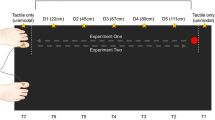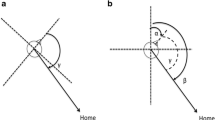Abstract
The principal goal of our study is to gain an insight into the representation of peripersonal space. Two different experiments were conducted in this study. In the first experiment, subjects were asked to represent principal anatomical reference planes by drawing ellipses in the sagittal, frontal and horizontal planes. The three-dimensional hand-drawing movements, which were achieved with and without visual guidance, were considered as the expression of a cognitive process per se: the peripersonal space representation for action. We measured errors in the spatial orientation of ellipses with regard to the requested reference planes. For ellipses drawn without visual guidance, with eyes open and eyes closed, orientation errors were related to the reference planes. Errors were minimal for sagittal and maximal for horizontal plane. These disparities in errors were considerably reduced when subjects drew using a visual guide. These findings imply that different planes are centrally represented, and are characterized, by different errors when subjects use a body-centered frame for performing the movement and suggest that the representation of peripersonal space may be anisotropic. However, this representation can be modified when subjects use an environment-centered reference frame to produce the movement. In the second experiment, subjects were instructed to represent, with eyes open and eyes closed, sagittal, frontal and horizontal planes by pointing to virtual targets located in these planes. Disparities in orientation errors measured for pointing were similar to those found for drawing, implying that the sensorimotor representation of reference planes was not constrained by the type of motor tasks. Moreover, arm postures measured at pointing endpoints and at comparable spatial locations in drawing are strongly correlated. These results suggest that similar patterns of errors and arm posture correlation, for drawing and pointing, can be the consequence of using a common space representation and reference frame. These findings are consistent with the assumption of an anisotropic action-related representation of peripersonal space when the movement is performed in a body-centered frame.







Similar content being viewed by others
References
Acredolo LP (1988) Infant mobility and spatial development. In: Stiles-Davis J, Kritchevsky M, Bellugi U (eds) Spatial cognition Brain bases and development. Lawrence Erlbaum Ass, Hillsdale, pp 157–166
Andersen RA (1997) Multimodal integration for the representation of space in the posterior parietal cortex. Philos Trans Roy Soc B 352:1421–1428
Andersen RA, Snyder LH, Bradley DC, Xing J (1997) Multimodal representation of space in the posterior parietal cortex and its use in planning movements. Annu Rev Neurosci 20:303–330
Arbib MA (1991) Interaction of multiple representations of space in the brain. In: Paillard J (eds) Brain and space. Oxford University Press, Oxford, pp 379–403
Badan M, Hauert CA, Mounoud P (2000) Sequential pointing in children and adults. J Exp Child Psychol 75:43–69
Batista AP, Buneo CA, Snyder LH, Andersen RA (1999) Reach plans in eye-centered coordinates. Science 285:257–260
Bisiach E, Vallar G (1988) Hemineglect in humans. In: Boller F, Grafman J (eds) Handbook of neuropsychology. Elsevier, Amsterdam, pp 195–222
Bisiach E, Perani D, Vallar G, Berti A (1986) Unilateral neglect: personal and extra-personal. Neuropsychologia 24:759–767
Blouin J, Bard C, Teasdale N, Paillard J, Fleury M, Forget R, Lamarre Y (1993) Reference systems for coding spatial information in normal subjects and a deafferented patient. Exp Brain Res 93:324–331
Bouisset S, Le Bozec (2002) Posturo-kinectic capacity and postural function in voluntary movements. In: Latash ML (ed) Progress in motor control, vol II. Human Kinetics Publishers, Champaign, pp 25–52
Bryant DJ, Tversky B, Franklin N (1992) Internal and external spatial frameworks for representing described scenes. J Mem Lang 31:74–98
Buneo CA, Jarvis MR, Batista AP, Andersen RA (2002) Direct visuomotor transformations for reaching. Nature 416:632–636
Burr IW (1974) Applied statistical methods. Academic, New York
Caminiti R, Ferraina S, Mayer AB (1998) Visuomotor transformations: early cortical mechanisms of reaching. Curr Opin Neurobiol 8:753–761
Carrozzo M, McIntyre J, Zago M, Lacquaniti F (1999) Viewer-centered and body-centered frames of reference in direct visuomotor transformations. Exp Brain Res 129:201–210
Cheron G, Draye JP, Bengoetxea A, Dan B (1999) Kinematics invariance in multi-directional complex movements in free space: effect of changing initial direction. Clin Neurophysiol 110:757–764
Coello Y, Grealy MA (1997) Effect of size and frame of visual field on the accuracy of an aiming movement. Perception 26:287–300
Colby CL, Duhamel JR (1996) Spatial representations for action in parietal cortex. Cogn Brain Res 5:105–115
Colby CL, Goldberg ME (1999) Space and attention in parietal cortex. Annu Rev Neurosci 22:319–349
Conti P, Beaubaton D (1980) Role of structured visual field and visual reafference in accuracy of pointing movements. Percept Mot Skills 50:239–244
Cowey A, Small M, Ellis S (1994) Left visuo-spatial neglect can be worse in far than in near space. Neuropsychologia 32:1059–1066
Desmurget M, Jordan M, Prablanc C, Jeannerod M (1997) Constrained and unconstrained movements involve different control strategies. J Neurophysiol 77:1644–1650
Flanders M, Tillery SI, Soechting JF (1992) Early stages in sensorimotor transformation. Behav Brain Sci 15:309–320
Franklin N, Tversky B (1990) Searching imagined environments. J Exp Psychol Gen 119:63–76
Friederici AD, Levelt WJ (1987) Resolving perceptual conflicts: the cognitive mechanism of spatial orientation. Aviat Space Environ Med 58:A164–A169
Friederici AD, Levelt WJ (1990) Spatial reference in weightlessness: perceptual factors and mental representations. Percept Psychophys 47:253–266
Fogassi L, Gallese V, Fadiga L, Luppino G, Matelli M, Rizzolatti G (1996) Coding of peripersonal space in inferior premotor cortex (area F4). J Neurophysiol 76:141–157
Georgopoulos AP (1994) New concepts in generation of movement. Neuron 13:257–68
Ghafouri M, Lestienne FG (2000) Altered representation of peripersonal space in the elderly human subject: a sensorimotor approach. Neurosci Lett 289:193–196
Ghafouri M, Archambault PS, Adamovich SV, Feldman AG (2002) Pointing movements may be produced in different frames of reference depending on the task demand. Brain Res 929:117–128
Graziano MS, Yap GS, Gross CG (1994) Coding of visual space by premotor neurons. Science 266:1054–1057
Halligan PW, Marshall JC (1991) Left neglect for near but not far space in man. Nature 350:498–500
Jeannerod M (1994) The representing brain: neural correlates of motor intention and imagery. Behav Brain Sci 17:187–245
Kalaska JF, Crammond DJ (1992) Cerebral cortical mechanisms of reaching movements. Science 255:1517–1523
Kalaska JF, Scott SH, Cisek P, Sergio LE (1997) Cortical control of reaching movements. Curr Opin Neurobiol 7:849–859
Knudsen EI, du Lac S, Esterly SD (1987) Computational maps in the brain. Annu Rev Neurosci 10:41–65
Lacquaniti F, Caminiti R (1998) Visuo-motor transformations for arm reaching. Eur J Neurosci 10:195–203
Lestienne FG, Gurfinkel VS (1988a) Postural control in weightlessness: a dual process underlying adaptation to an unusual environment. Trends Neurosci 11:359–363
Lestienne FG, Gurfinkel VS (1988b) Posture as an organizational structure based on a dual process: a formal basis to interpret changes of posture in weightlessness. Prog Brain Res 76:307–313
Levelt WJM (1984). Some perceptual limitations in talking about space. In: Van der Grind AJ, Koenderink JJ (eds) Limits in perception. VNU Science Press, Utrecht, pp 323–358
Marendaz C, Stivalet P, Barraclough L, Walkowiac P (1993) Effect of gravitational cues on visual search for orientation. J Exp Psychol Human 19:1266–1277
Massion J (1998) Postural control systems in developmental perspective. Neurosci Biobehav Rev 22:465–472
McIntyre J, Stratta F, Lacquaniti F (1998) Short-term memory for reaching to visual targets: psychophysical evidence for body-centered reference frames. J Neurosci 18:8423–8435
Mittelstaedt H (1986) The subjective vertical as a function of visual and extra retinal cues. Acta Psychol 63:63–85
Mittelstaedt H (1992) Somatic versus vestibular gravity reception in man. In: Sensing and controlling the motion: vestibular and sensorimotor function. Ann N Y Acad Sci, New York 656:124–139
Mittelstaedt H (1997) Interaction of eye-, head- and trunk-bound information in spatial perception and control. J Vestibul Res 7:283–302
Olson CR (2003) Brain representation of object-centered space in monkeys and humans. Annu Rev Neurosci 26:331–354
Olson CR, Gettner SN (1995) Object-centered direction selectivity in the macaque supplementary eye field. Science 269:985–988
Paillard J (1971) Les déterminants moteurs de l’organisation spatial. In: Jeddi J (ed) Le corps en psychiatrie. Masson, Paris, pp 53–69
Parker DE, Poston RL, Gulledge WL (1983) Spatial orientation: Visual-vestibular-somatic interaction. Percept Psychophys 33:139–146
Penfield W, Rasmusson T (1950) The cerebral cortex of man: a clinical study of localization of function. Macmillan, New York
Petersen RS, Diamond ME (2002) Topographic maps in the brain. In: Encyclopedia of life sciences, Nature Publishing Group, London
Pozzo T, Papaxanthis C, Stapley P, Berthoz A (1998) The sensorimotor and cognitive integration of gravity. Brain Res Rev 28:92–101
Rizzolatti G, Riggio L, Sheliga BM (1994) Space and selective attention. In: Ulmilta C, Moscovitch M (eds) Attention and performance, vol 15. MIT Press, Cambridge, pp 231–265
Rizzolatti G, Fogassi L, Gallese V (1997) Parietal cortex: from sight to action. Curr Opin Neurobiol 7:562–567
Rushworth MF, Johansen-Berg H, Young SA (1998) Parietal cortex and spatial-postural transformation during arm movements. J Neurophysiol 79:478–482
Scheerer E (1984) Motor theories of cognitive structure: A historical review. In: Prinz W, Sanders AF (eds) Cognition and motor processes. Springer, Berlin Heidelberg New York, pp 77–97
Schöne H. (1964) On the role of the gravity in the human spatial orientation. Aerospace Med 8:764–772
Schöne H, Udo de Haes H (1971) Space orientation in humans with special reference to the interaction of vestibular, somaesthetic and visual inputs. In: Drischel H, Tiedt N (eds) Biokybernetik III. VEB Gustav Fischer Verlag, Jena , pp 172–191
Schoumans N, Koenderink JJ, Kappers AM (2000) Change in perceived spatial directions due to context. Percept Psychophys 62:532–539
Schwartz AB, Moran DW (1999) Cortical activity during drawing movements: population representation during lemniscate tracing. J Neurophysiol 82:2705–2718
Snyder LH, Grieve KL, Brotchie P, Andersen RA (1998) Separate body- and world-referenced representations of visual space in parietal cortex. Nature 394:887–891
Soechting JF, Lacquaniti F, Terzuolo CA (1986) Coordination of arm movements in three-dimensional space Sensorimotor mapping during drawing movement. Neuroscience 17:295–311
Soechting JF, Terzuolo CA (1986) An algorithm for the generation of curvilinear wrist motion in an arbitrary plane in three-dimensional space. Neuroscience 19:1393–405
Soechting JF, Flanders M (1992) Moving in three-dimensional space: frames of reference, vectors, and coordinate systems. Annu Rev Neurosci 15:167–191
Stein JF (1992) Representation of egocentric space in the posterior parietal cortex. Behav Brain Sci 15:691–700
Templeton WB (1973) The role of gravitational cues in the judgement of visual orientation. Percept Psychophys 14:451–457
Thullier F, Moufti H (2004) Multi-joint coordination in ballet dancers. Neurosci Lett 369:80–84
Vallar G, Bisiach E, Cerizza M, Rusconi ML (1988) The role of the left hemisphere in decision-making. Cortex 24:399–410
Viviani P, Schneider RA (1991) developmental study of the relationship between geometry and kinematics in drawing movements. J Exp Psychol Human 17:198–218
Weiss PH, Marshall JC, Wunderlich G, Tellmann L, Halligan PW, Freund HJ, Zilles K, Fink GR (2000) Neural consequences of acting in near versus far space: a physiological basis for clinical dissociations. Brain 123:2531–2541
Yantis S, Serences JT (2003) Cortical mechanisms of space-based and object-based attentional control. Curr Opin Neurobiol 13:187–193
Author information
Authors and Affiliations
Corresponding author
Rights and permissions
About this article
Cite this article
Ghafouri, M., Lestienne, F.G. Contribution of reference frames for movement planning in peripersonal space representation. Exp Brain Res 169, 24–36 (2006). https://doi.org/10.1007/s00221-005-0121-z
Received:
Accepted:
Published:
Issue Date:
DOI: https://doi.org/10.1007/s00221-005-0121-z




